11 Best Day Trips from Madrid By Train or Car

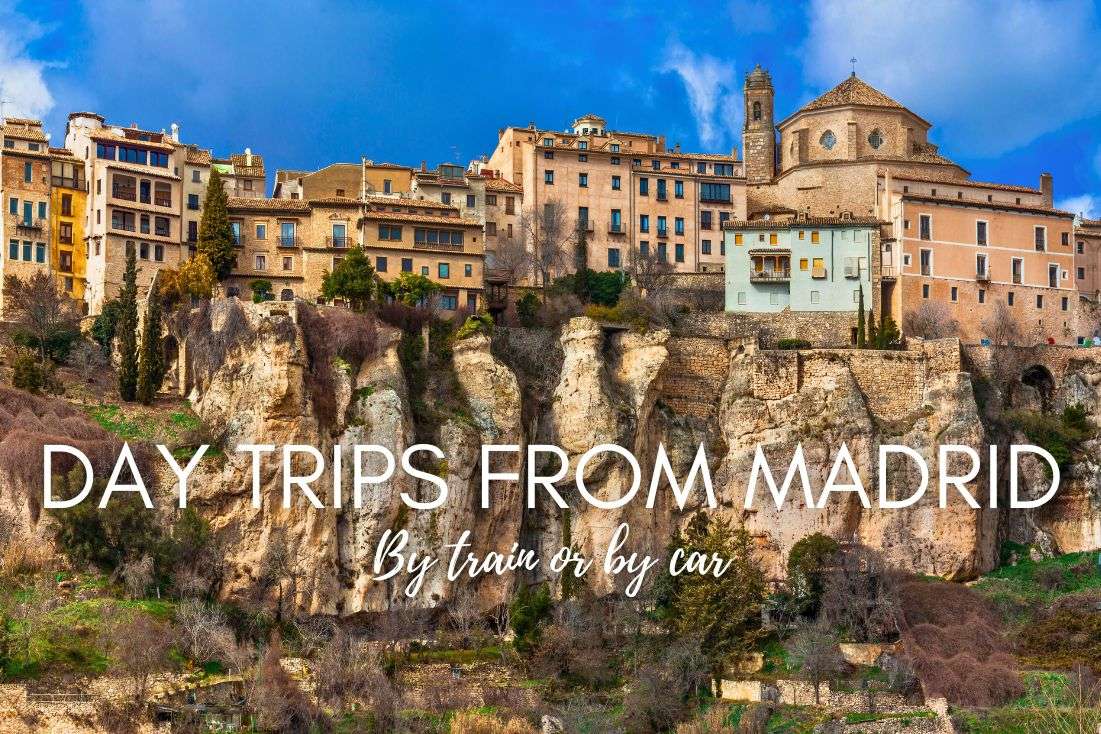
Madrid has its moments—great food, compact city center, and fantastic museums. But honestly, it can be a bit of a yawn-fest after a couple of days. The architecture is nothing to write home about unless you have a thing for boring classicist styles or are a lawyer (hence you love the boring classist styles).
So, why not escape the city and explore some incredible spots nearby? Madrid couldn’t keep me entertained for more than 2 days, but these day trips, especially the historical towns, are absolutely worth your time. Except for the ones that aren’t (sorry, but you can’t turn Madrid into a beach vacation)! Here’s a rundown of day trips that might be even better than Madrid itself.
And by the way, trains from Madrid are fantastic. They’re often faster and more convenient than driving. I usually drive a rental car everywhere I travel, but even I have to admit that the high-speed trains can be game-changers. Some of these day trips from Madrid by train take less than half the time of driving!
For each day trip below, I’ll include car and train travel times and train station info, top attractions, and my overall opinion of the trip.
A map of day trips from Madrid
These are the day trips from Madrid that actually make sense... (get my saved list on Google Maps)
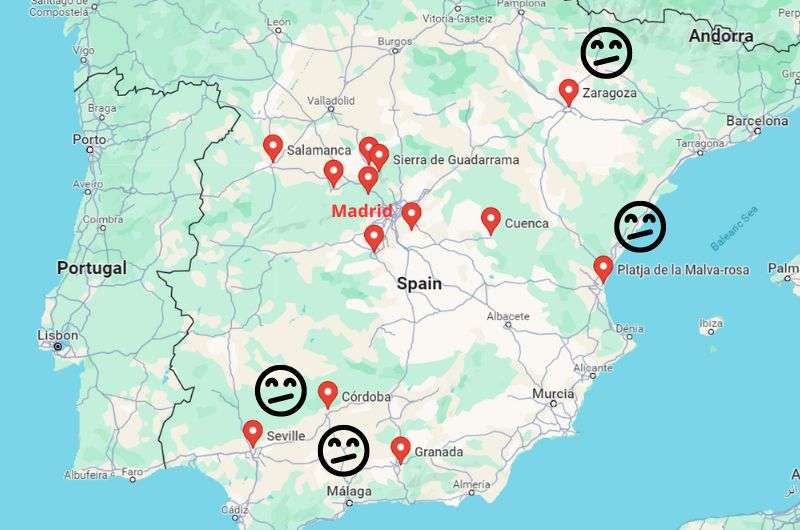
...while some places are a stretch. Might as well take a day trip to Lisbon while you’re at it!
Quick list of day trips from Madrid
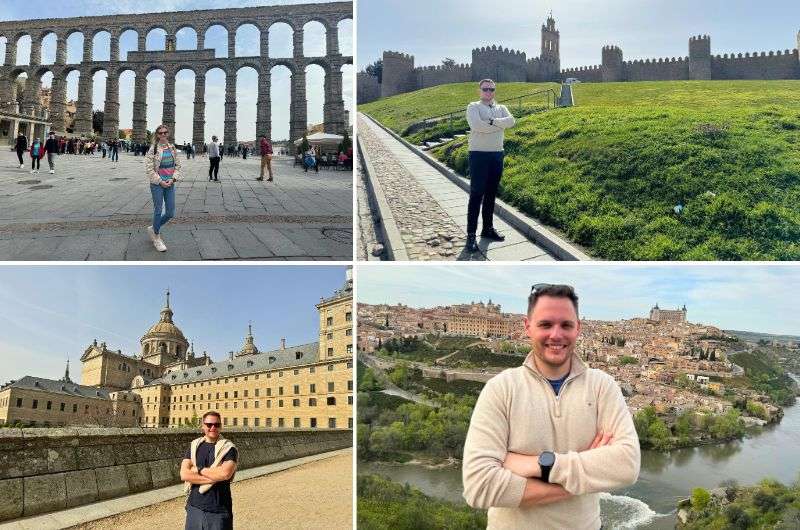
I have done all of these day trips recently and I have described my experiences in detail in separate articles in the Spain section of the blog
If you just want a quick list of the top places to visit on a day trip from Madrid, you’re in luck. I’ve got just the thing for you. And overview of day trips (by train and car) from Madrid:
- Segovia
- What it is: Roman aqueduct, fairy-tale castle, medieval charm.
- Travel Time: 1.5 hours by car, 30 minutes by high-speed train.
- Review: 9/10
- Ávila
- What it is: Medieval walls, Gothic churches, serene vibes.
- Travel Time: 1.5 hours by car, 1 hour 20 minutes by train.
- Review: 8/10
- Toledo
- What it is: History overload with Christian, Muslim, and Jewish influences.
- Travel Time: 1 hour by car, 30 minutes by high-speed train.
- Review: 9/10
- El Escorial
- What it is: Historic royal site with a monastery and palace.
- Travel Time: 1 hour by car, 1 hour by train.
- Review: 9/10
- Cuenca
- What it is: Hanging houses, dramatic scenery, quaint town.
- Travel Time: 2 hours by car, 1 hour by train.
- Review: 6/10
- Salamanca
- What it is: University town, stunning architecture, lively nightlife.
- Travel Time: 2.5 hours by car, 1 hour 40 minutes by train.
- Review: 8/10
- Chinchón
- What it is: Charming village, medieval plaza, relaxed atmosphere.
- Travel Time: 45 minutes by car.
- Review: 5/10
- Hiking in Madrid: Sierra de Guadarrama
- What it is: Scenic hikes, fresh air, beautiful views.
- Travel Time: 1 hour by car, 1 hour by train.
- Review: 8/10
- Beach day trip from Madrid
- What it is: Nearest beach is in Valencia, too far for a day trip.
- Travel Time: 3.5 hours by car, 2 hours by train.
- Review: 3/10
- Andalusia? Not for a Day Trip!
- What it is: Culture and history galore, but needs more time.
- Travel Time: 2-4 hours one way by high-speed train.
- Review: 5/10 for a day trip, 10/10 for a proper visit
- Zaragoza? Think Twice!
- What it is: Historical landmarks and modern architecture, but underwhelming.
- Travel Time: 3 hours by car, 1 hour 15 minutes by train.
- Review: 5/10
These day trips offer a variety of experiences that might make you forget about Madrid altogether. Explore, enjoy, and make the most of your stay!
Sometimes, all you need to do is take the first step... find your dream hotel in Madrid now
Save it for yourself to come back to later, or share with your friends on social media!
I've already planned your ititnerary for the trip, complete with my travel tips.
1. Day trip from Madrid to Segovia
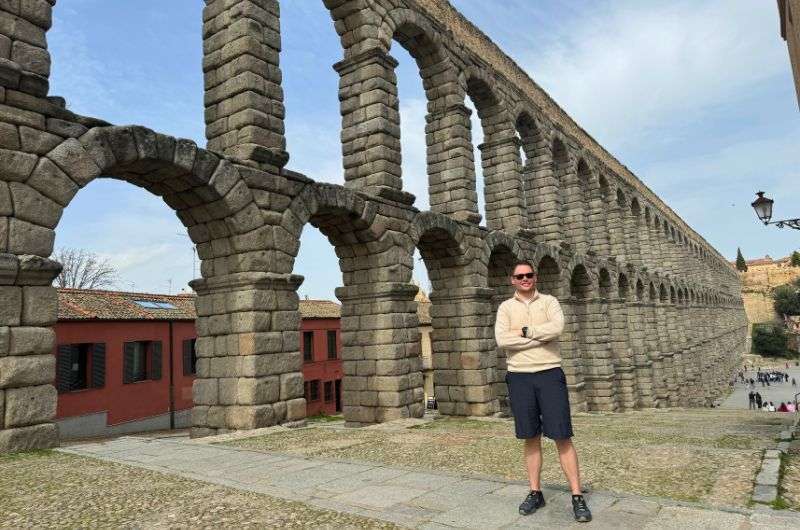
Segovia is a historical city full of lots of cool things to see
- Driving time: 1.5 hours
- Train travel time: 30 minutes by high-speed train (AVE) from Madrid Chamartín Station
- Review: 9/10
- What it is: A historical town famous for its Roman aqueduct, fairy-tale castle, and medieval architecture.
Segovia is a UNESCO Heritage Site perched on a limestone ridge, which makes it look stunning from the numerous viewpoints outside of the historic center—no wonder the miradores topped by list of the best things to do in Segovia! The town's most iconic landmark is the Roman aqueduct, an engineering marvel that has stood the test of time for nearly 2,000 years. Without mortar!
Gotta love a picturesque town that offers a perfect blend of ancient history and stunning scenery! The massive Gothic cathedral is dwarfed by the huge and enchanting Alcázar (castle), which looks like there should be dragons flying out of it.

Segovia is one of my favorite day trips from Madrid
I was fascinated by the town's medieval streets, which had just the right amount of attractions and charm to make Segovia one of my favorite day trips from Madrid.
Getting there
The high-speed AVE train from Madrid’s Chamartín Station gets you to Segovia in less than 30 minutes and for about EUR 14 for the cheapest tickets. Trains are frequent and efficient, making this the best option.
If you prefer driving, it takes about 1 hour 30 minutes, but parking in Segovia can be challenging and expensive. The train is the way to go on this one.
Train station Segovia
If you’re coming by train (which you should, because parking here is about as easy as finding a unicorn), the station is conveniently just south of the city center. A quick taxi or 20-minute walk will get you to the heart of the action.
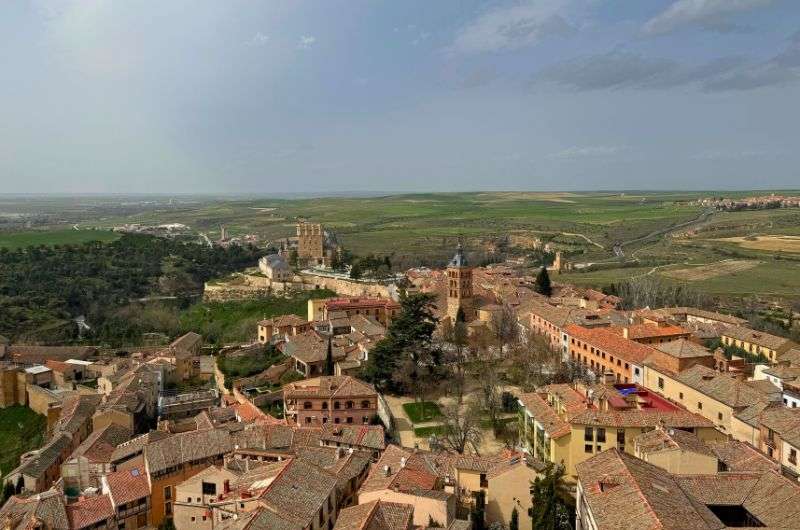
View of Segovia from the Cathedral
Orientation
Segovia is compact and easily walkable, but expect to cover at least 8 km (5 mi) as you explore the city. The main sights are clustered together, with the Roman aqueduct at the entrance to the historic center and the Alcázar at the far end.
Main attractions in Segovia
- Viewpoints (Miradores): The best place to start your day trip is the various viewpoints in the northwest of the city. These spots offer stunning perspectives of the Alcázar and the cathedral, but they require a little bit of leg work.
- Segovia Cathedral: The last Gothic cathedral built in Europe, a massive building where you can climb up to its tower for panoramic views.
- Segovia Castle (Alcázar de Segovia): Explore the castle that inspired Disney! The military museum inside is a dream come true for history nerds and anyone who ever swung a stick around pretending it was a sword.
- Roman Aqueduct: This ancient engineering marvel is a must-see, with its towering arches and fascinating history.
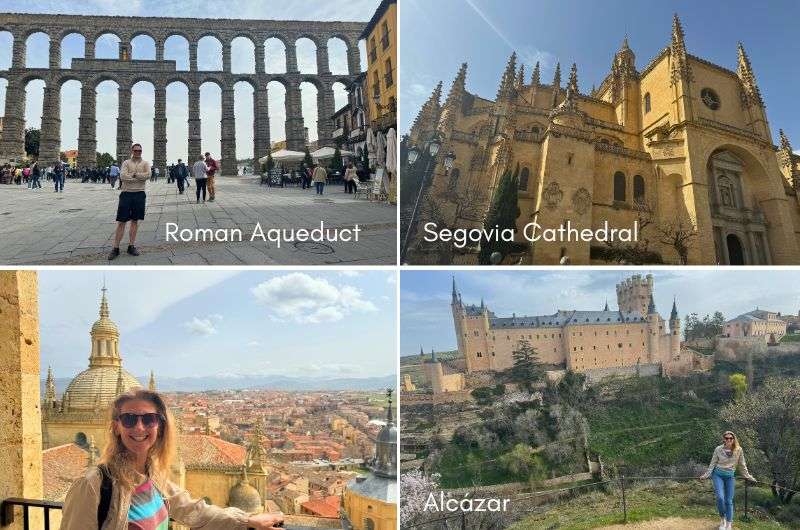
My favorites from Segovia
- Royal Mint (Real Casa de Moneda de Segovia): Learn about the history of coin minting in Spain at this fascinating museum. Don’t miss the waterwheels and the Interpretation Center of the Aqueduct.
- Plaza Mayor and Royal Mile (Calle Real): No day trip is complete without a stroll along a town’s main street! Segovia’s is lined with historical buildings and shops, leading from the aqueduct to the cathedral.
- San Martin Church (Iglesia de San Martin): A Romanesque church with a striking golden altar.
- Casa de los Picos: Known for its unique façade covered in granite points, this building is a quick, semi-interesting stop.
- Jewish Quarter: Wander through the narrow, atmospheric streets of Segovia’s historic Jewish quarter.
- Sanctuary of Our Lady of Fuencisla (Santuario de Nuestra Señora de la Fuencisla): A peaceful spot with beautiful views to end (or start) your day. Close to the viewpoints.

We couldn't miss this Segovian specialty—cochinillo
- Cochinillo: Try the local delicacy and Segovia’s star dish, roast suckling pig. Best eaten for dinner, because you will be fuller than full! José María Restaurant is one of the renowned restaurants to eat it at.

2. Day trip from Madrid to Ávila
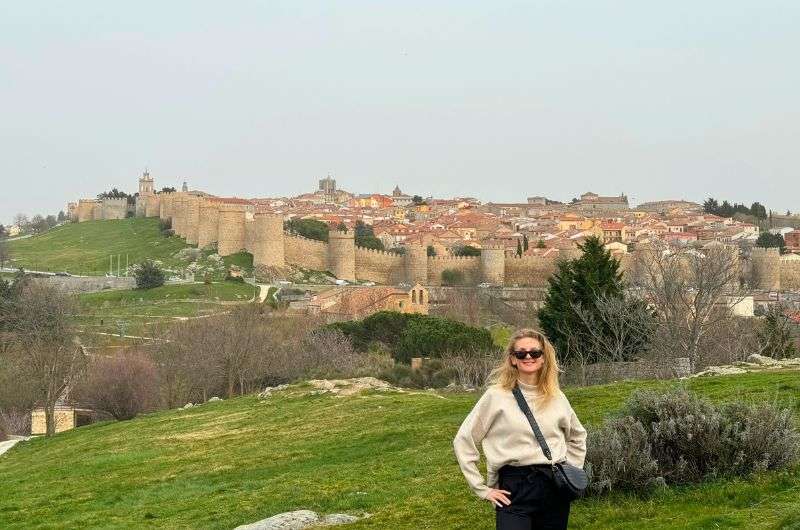
Now it’s Ávila’s turn!
- Driving time: 1.5 hours
- Train travel time: 1.5 hours from Madrid Chamartín Station or Madrid Príncipe Pio
- Review: 8/10
- What it is: A fortified medieval town with fantastically preserved city walls
Ávila had me falling head over heals with its atmosphere. Known for its incredibly well-preserved medieval walls that turns into the world’s largest illuminated monuments each evening, Ávila is a city that breathes history. And I love me some history!
Besides its incredibly large city gates and walls that offer awesome views, Ávila is a UNESCO World Heritage site that is full of monasteries and St. Theresa everything. Yes, Ávila the birthplace of St. Teresa, so you’ll find a great deal of attractions are dedicated to her.
It’s also the highest provincial capital in Spain, meaning the temperatures are lower than in Madrid and other famous day trip destinations. A godsend in the summer!
Getting there
While you can take a train from Madrid’s Chamartín Station to Ávila, there is no fast train, so the journey will take about 1 hour 30 minutes (tickets cost as little as EUR 9.25). Renting a car is highly recommended. Driving gives you the flexibility to explore at your own pace and visit attractions outside the city center. There is ample parking near the city center.
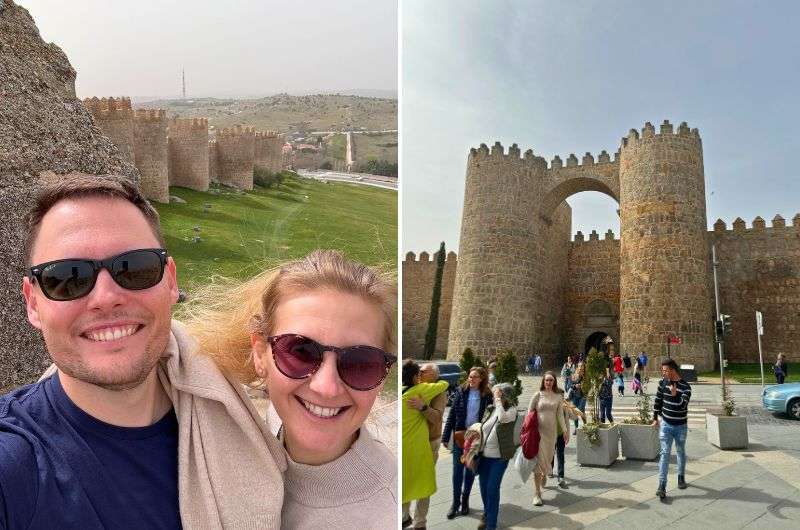
You can walk the entire walls that stretch around Ávila
Ávila train station
Ávila’s train station is located 1.2 km (0.7 mi) to the east of the walled city center, which will take 15–20 minutes of walking, depending on how excited you are to get there and start exploring. Alternatively, taxis are always an option.
Orientation
Ávila’s historical center is surrounded by its famous walls, making it easy to navigate on foot—if you run into the wall, you’ve gone out too far. Most major attractions are within walking distance, but a car is useful for reaching some of the more remote sights. I suspect many people that get to Ávila by train from Madrid don’t ever reach these “bonus” spots, like the Royal Monastery of St. Thomas or the Monastery of Incarnation, which is a real shame!
Main attractions in Ávila
- Walls of Ávila: No biggie, just the best-preserved city walls in the entire world! These walls stretch for about 2.5 km and feature 87 towers and 9 gates. An audio guide provides fascinating insights as you enjoy panoramic views of the city and surrounding countryside.
- Ávila Cathedral: Explore Spain’s first Gothic cathedral. The cathedral’s raw brick interior and beautiful stained-glass windows make it a standout. I especially loved the VR experience at the end of the tour.
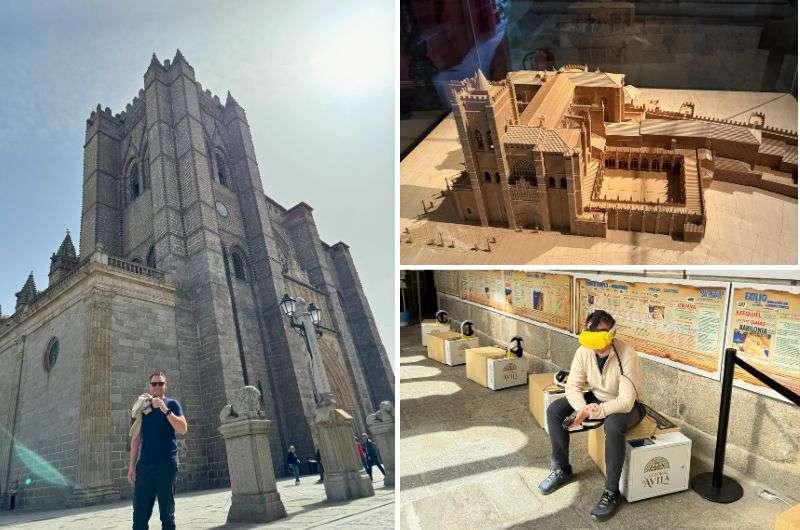
The tour of Ávila Cathedral was interactive and fun
- Palace of Polentinos: Visit this former military academy, now housing the General Military Archive—an obvious favorite of mine. The interactive exhibits, including some cool VR experiences, make it an engaging visit.
- Convent and Museum of Saint Teresa: The site where Saint Teresa was born and where she lived, experienced miracles and mystical experiences.
- Monastery of Incarnation: Learn about the life of Saint Teresa at this monastery where she lived for nearly 40 years. It was interesting to see her original artefacts and, for example, the room in which she would meditate (and levitate?).
- Royal Monastery of St. Thomas: This grand monastery, a blend of Romanesque and Gothic styles, houses a former royal palace and several museums.
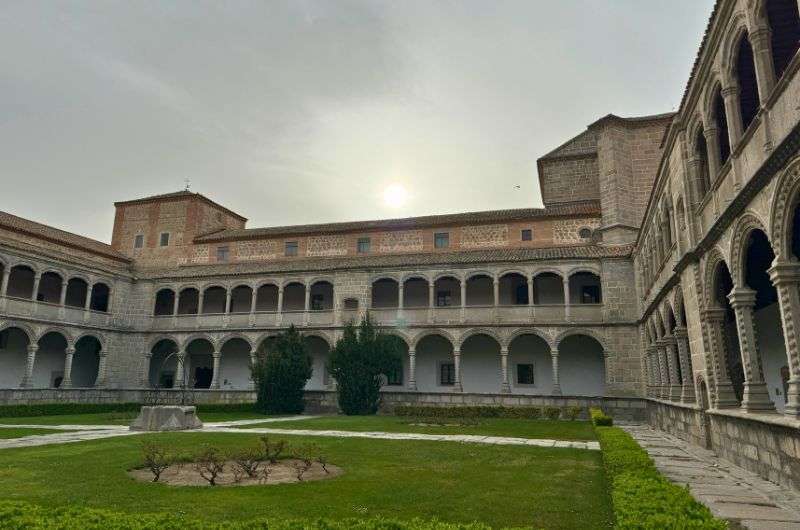
Royal Monastery of St. Thomas
- Cuatro Postes Viewpoint: For the best views of Ávila, head to this popular spot outside the city walls. It’s perfect for capturing stunning photos of the illuminated walls at sunset.
- Basilica of St. Vincent: This Romanesque church, built on the site where Saints Vincent, Sabina, and Cristeta were martyred, features a beautifully carved cenotaph and colorful interior stones.

3. Day trip from Madrid to Toledo
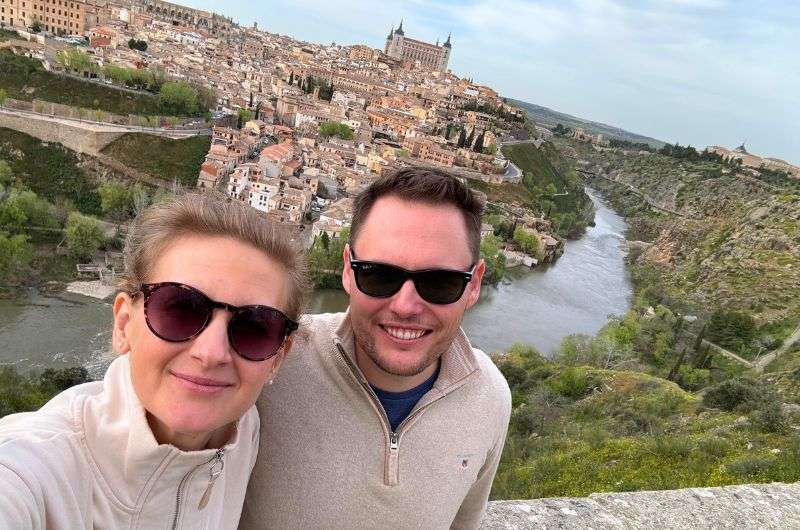
Toledo was great!
- Driving time: 1 hour 15 minutes
- Train travel time: 30 minutes by high-speed train (AVE) from Madrid Atocha Station
- Review: 9/10
- What it is: A historic city known combining influences from Christians, Jews, and Muslims
Toledo is a powerhouse of history and culture. This city is another one perched on a hill (with escalators to help you get up there), this time above the Tagus River, and it’s a blend of Arab, Jewish, and Christian heritage.
The narrow, winding streets are packed with ancient walls, grand cathedrals, and bustling plazas. Once the capital of Spain, Toledo is famous for its imposing Alcázar with its amazing army museum inside and the majestic Toledo Cathedral. If you're into rich history and stunning buildings, Toledo is a must-see that’s easy to get to from Madrid. This place will blow your mind.
Tip: If you can, stay overnight to experience Toledo’s magic without the day-trip crowds. Hotel Boutique Adolfo is a great choice. I’d even go as far as to base myself in Toledo and do day trips from there!
Getting there
From Madrid, the high-speed AVE train from Atocha Station will whisk you to Toledo in just 30 minutes. Trains leave at least once an hour and cost around EUR 14 per person.
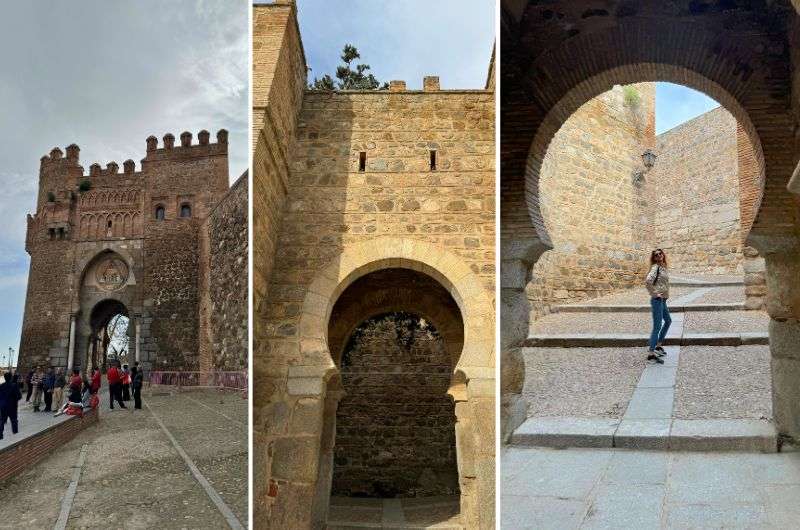
Gates of Toledo
If you prefer to drive, it takes about 1 hour 15 minutes. Park near the city gates in the northern part of the city—either in the underground garages or parking lots outside the old town.
Toledo train station Spain
The train station in Toledo is 1.5 km (1 mi) to the east of the city gates—a bus, taxi, or your own two feet can take you to the city center. You can use the outdoor escalators to navigate the steep inclines in Toledo, like this Safont escalator which is useful if you’re coming from the train station.
Orientation
Like most hilltop towns, Toledo Spain is also easily walkable. You’ll probably walk around 5 km (3 mi) at the very least during your day trip, but overall all the sights are close together. The city is hugged by the Tagus River on three sides, so the main place to enter the historical center on the northern end. If you're driving, aim to park near Bisagra Gate for easy access to the main attractions.
Main attractions in Toledo Spain
- Walls and gates of Toledo: You’ll start your visit at the imposing Puerta de Bisagra, then walk along the ancient walls that have guarded the city for centuries. Sometimes I can’t believe that this used to be real life! Don’t miss Puerta del Sol, a stunning example of Mudéjar architecture.
- Bridge of Alcántara: A picturesque spot for photos, this Roman-era bridge offers great views of the city’s skyline.
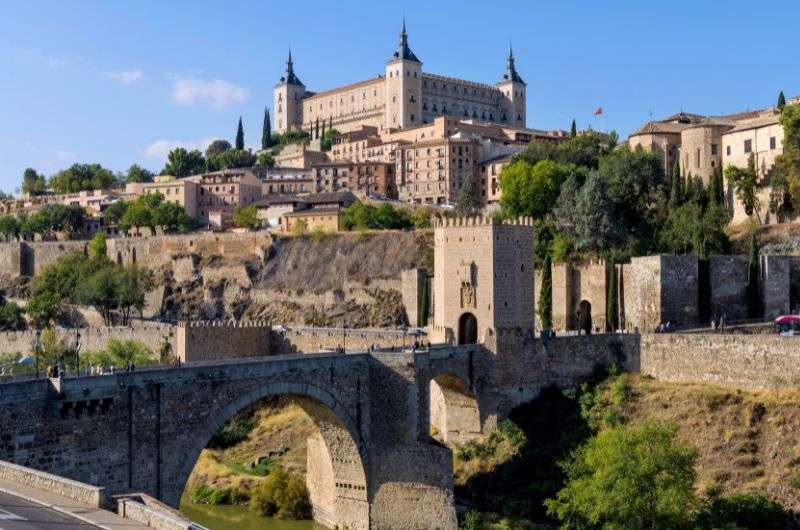
Bridge of Alcántara
- Museo Cromática: A quirky, vibrant museum/gallery featuring colorful, artistically enhanced musical instruments. Random, I know, but oh so good! Tickets include a welcome drink and entry to live concerts.
- Alcázar of Toledo: Explore this historical fortress that houses a fantastic—like, really fantastic!— military museum. Make sure to visit the secret terrace for panoramic city views.
- Toledo Cathedral: A Gothic masterpiece with impressive art collections, including works by El Greco, Velázquez, and Caravaggio.
- Convento de los Reyes: A serene and less crowded Gothic monastery. I personally loved the courtyard and the lack of people there.
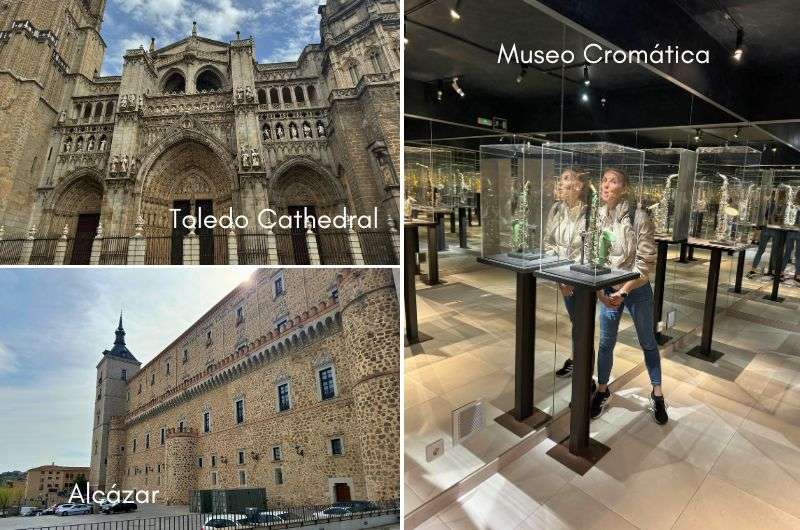
One of the top things to do in Toledo
- Sephardic Museum and Synagogue: Dive into Toledo’s Jewish heritage in this beautiful former synagogue.
- El Greco Museum: Dedicated to the life and works of the iconic painter, El Greco.
- Mosque of Christ: And to top it all off, a fascinating mix of Islamic and Christian architecture, aka Christ on a Cross in a mosque.
- Manchego Museum: Cheese lovers will enjoy learning about and tasting Spain’s famous Manchego cheese.
- Mirador del Valle: End your day with breathtaking panoramic views of Toledo. This is the best spot to get them from.

4. Day trip from Madrid to El Escorial
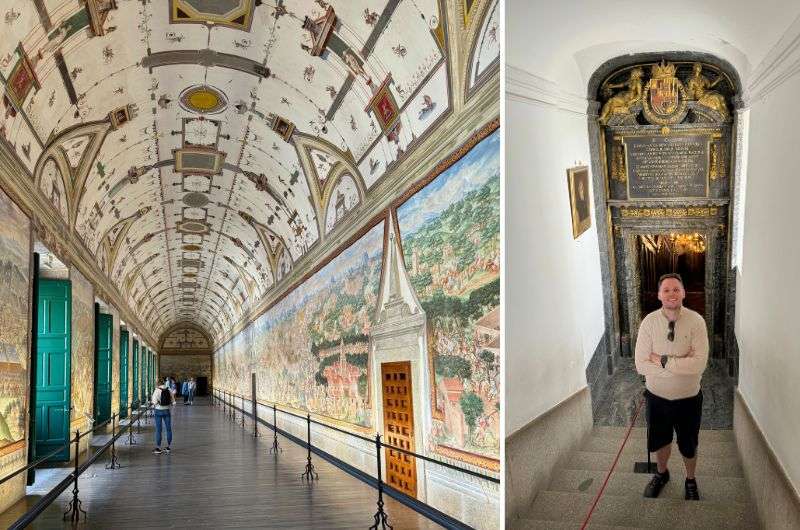
Hall of Battles at El Escorial Palace
- Driving time: 1 hour
- Train travel time: 1 hour from Madrid Atocha Station or Madrid Chamartín Station
- Review: 9/10
- What it is: A royal site and historical residence of the King of Spain.
Tucked in the foothills of the Sierra de Guadarrama, El Escorial is truly a sight to behold—a monster! It's not just a grand complex; it's the grandest I’ve ever seen—think of it as Spain’s answer to Versailles, which I haven’t seen before, so it’s the largest palace I’ve been to date. Just the basilica took 20 minutes to get through!
From the moment I stepped inside, I was captivated by how this immense structure combines a royal palace, monastery, and mausoleum under one roof. The exterior may be austere, but once you’re inside, the grandeur hits you like a ton of bricks—exactly the kind of contrast I love.
I’d try to visit outside of peak tourist months, because I can imagine how busy it can get. We were at El Escorial in April and there were no lines. If you can, join a guided tour. It adds so much more depth to the experience, especially when it comes to the historical and architectural details.
Oh, and take a sweater, the basilica could double as a fridge.
Getting there
From Madrid, you can take a train from Atocha Station or Chamartín Station to El Escorial, which takes about 1 hour. Trains run frequently, making this a convenient option. If you prefer driving, it’s about a 1-hour drive, and there is parking available near the palace.
Train station in El Escorial
The train station in El Escorial is conveniently located in the town of San Lorenzo de El Escorial, about 1.5 km (1.2 mi) from the main entrance of the palace complex.
From the station, it’s an easy 15- to 20-minute walk to the palace. The route is well-marked, so you won’t have any trouble finding your way. As you stroll through the town, you’ll pass charming cafes and shops, giving you a taste of local life before you reach the contrasting grandeur of El Escorial. The walk is mostly uphill, so wear comfortable shoes.
If you prefer not to walk, there are taxis available at the train station.
Orientation
El Escorial is easy to navigate and the signage is clear, so you won’t get lost. Once inside, you’ll find everything well laid out, with signs guiding you through the various sections. The entire complex is vast, but the main attractions are concentrated, so you can cover a lot without feeling overwhelmed.

El Escorial
Get a guided tour if you want to do no work whatsoever. Otherwise you can get an audio guide on your phone.
El Escorial tickets
Tickets to El Escorial can be bought online if you want to secure your spot at a specific time or are visiting in a busy period. Regular tickets cost EUR 14, an audio guide costs EUR 5 extra.
Consider joining a guided tour to fully appreciate the historical and architectural significance of the site. This costs EUR 20 and takes 2 hours. Many of them are only in Spanish, so definitely look online to see if you can find an English one on your dates if you need it.
El Escorial opening hours
Tuesday to Sunday 10 am–7 pm, closed Mondays.
Main attractions at El Escorial
- Basilica: If there’s one word to describe the basilica, it’s epic. The size alone is mind-boggling, but the real magic is in the details—like the massive altar adorned with golden statues. I’d recommend spending a good 20 minutes here, just soaking in the atmosphere. The ceilings, especially, are awe-inspiring, so don’t forget to look up!

The decorated ceilings of the basilica were unbelievable
- Pantheon of the Kings and Pantheon of the Princes: Well, it’s basically a cemetery—kind of morbid, but the coffins are incredibly beautiful. The entire Spanish dynasty rests here, up until the modern era. At the end, there’s the mausoleum of the Spanish kings. It’s both morbid and beautiful. Even Charles V, one of my favorite kings and historical figures, is buried here, along with Philip II. Honestly, this would be an ideal mausoleum for me.
- Habsburg Palace: It’s a classic Renaissance residence, though a bit sparsely furnished—likely because it’s known that the king preferred an ascetic lifestyle, unlike me, who enjoys a bit more comfort. The doors alone are so intricately decorated that I’m convinced people back then could have bought an entire house for what they cost. One thing that really caught my attention were the incredibly detailed genealogies of the royal families connected to Spain, which totally feeds my OCD tendencies.
- And then there’s the Hall of Battles, which is easily one of the most fascinating rooms in the entire complex. It’s filled with beautifully interconnected scenes of historical battles, flowing seamlessly from one to the next. This, along with the pantheon, was probably one of my favorite parts of the visit. I couldn’t help but think to myself that unlike some places I recently visited in Japan, there’s actually a lot to see inside!
- Library: Now, this is a feast for the eyes. Home to thousands of manuscripts and books, the library’s frescoes are absolutely stunning. I found myself lingering here longer than expected, just admiring the details.
- Gardens: After all that history, the gardens are a perfect retreat. They’re meticulously maintained and offer wonderful views of the surrounding mountains. Honestly, you can see them in 10 minutes, but still, it’s a peaceful spot to chill out after exploring the palace.
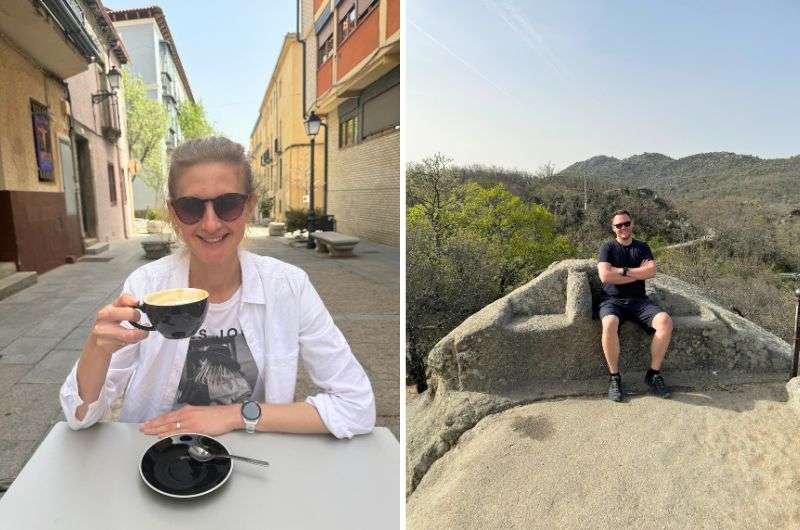
El Escorial is also about coffees and views
We then took El Escorial to the next level and explored the surroundings of the palace. So much to see, so little time!
5. Day trip from Madrid to Cuenca
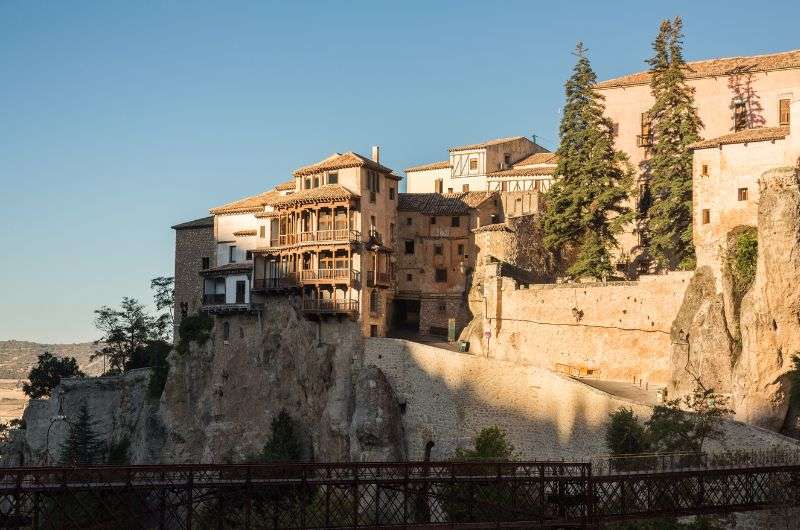
Cuenca, a city where the houses hang over a rocky ridge
- Driving time: 2 hours
- Train travel time: 1 hour by high-speed train from Madrid Atocha Station or Madrid Chamartín Station to Cuenca Fernando Zobel
- Review: 6/10
- What it is: A city known for its "hanging houses"
Cuenca may not look like much as you first approach—it seems modern and disappointingly ugly. But don’t be deceived. Once you reach the old town, perched dramatically on a rocky ridge, you'll find why this is one of the most popular day trips from Madrid.
This UNESCO World Heritage site is famous for its "hanging houses" (casas colgadas), which precariously cling to the cliffside above the Huécar River gorge. Cuenca perfectly marries natural beauty with medieval architecture, making it a visually stunning and culturally rich destination.
Getting there
High-speed trains from Madrid’s Atocha or Chamartín Stations gets you to Cuenca in about 1 hour. Trains are frequent and reliable, making this a relatively easy option, even though the train station is annoyingly far from the city. Get your tickets in advance because they can range from EUR 16 to EUR 65. You know what they say: the early bird gets the cheap tickets!
If you prefer to drive, it takes about 2 hours, with plenty of parking options available near the city, and even a parking garage right in the Old Town for about EUR 2 per hour. Plus, if you have your own car you can easily stop by another day trip option and make a great combo: the cute town of Chinchón (read more about it further down on this list).
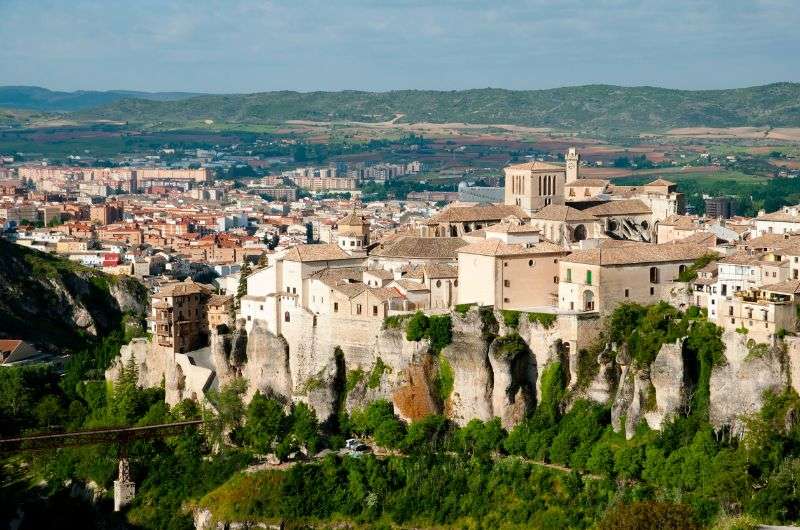
Don't worry, you don't have to climb those rocks to get to Cuenca. Bridge of San Pablo on the bottom left
Orientation
Cuenca’s Old Town is compact and walkable, but you’ll need to a taxi if you arrive by train.
Cuenca train station
High-speed trains from Madrid arrive at Cuenca Fernando Zobel Train Station, which is far from the city—5.5 km (3.5 mi) from the hanging houses part of town to be exact. You are best off getting a taxi from the train station to the city, though I’m sure buses exist as well.
Main attractions in Cuenca
- Hanging houses (Casas Colgadas): The iconic symbol of Cuenca, these medieval houses jut out over the edge of the gorge, offering spectacular views and a unique photo opportunity. Don’t miss the Museum of Abstract Art housed within one of these houses (if that’s your thing).
- Cuenca Cathedral: Located in the Plaza Mayor, this impressive Gothic cathedral dates back to the 12th century. The interior is stunning, with intricate altarpieces and beautiful stained-glass windows. The triforium offers both a stunning internal view of the nave and an external perspective through the arches above the Gothic facade.
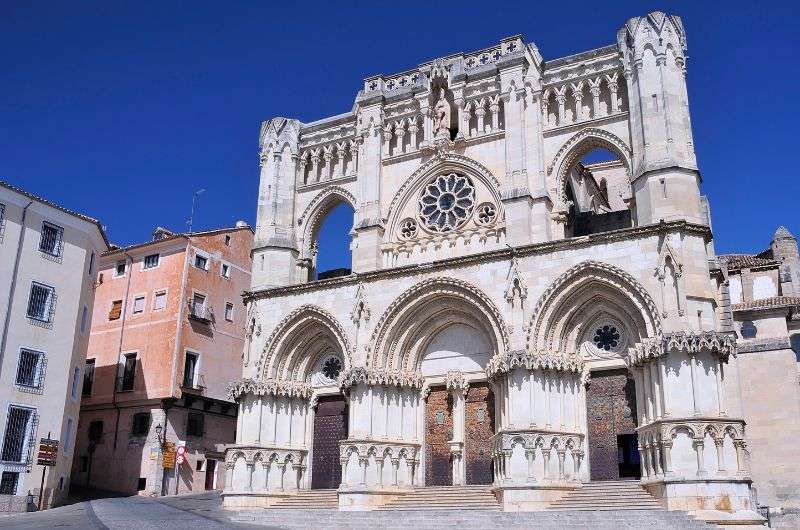
Cathedral de Cuenca
- Bridge of San Pablo: This iron bridge offers the most sought-after views of the hanging houses and the gorge below.
- Old Town streets: Wander through the narrow, winding streets of Cuenca’s old town, lined with colorful houses and little plazas. Highlights include the Plaza Mayor, the Mangana Tower, and numerous churches and convents.
- Museums: Cuenca boasts several interesting museums, including the Museum of Spanish Abstract Art, the Museum of Cuenca, and the Science Museum, each offering unique insights into the city’s artistic and historical heritage.
6. Day trip from Madrid to Salamanca
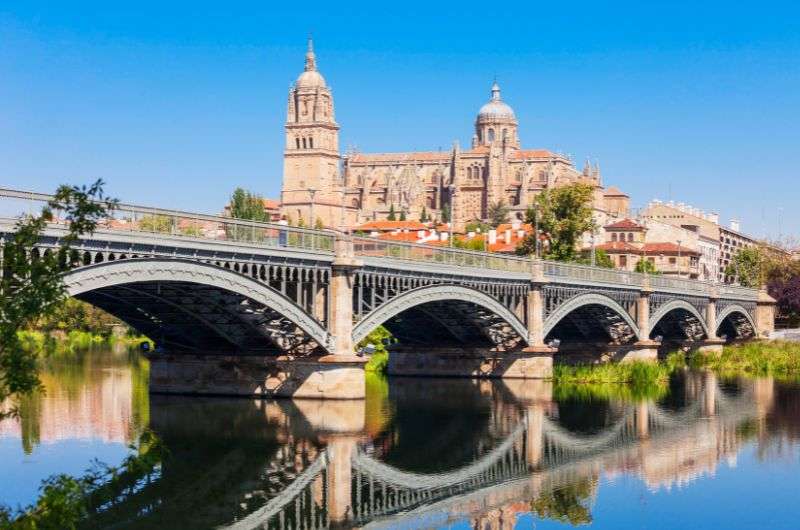
Salamanca
- Driving Time: 2.5 hours
- Train Travel Time: 1 hour 40 minutes by high-speed train from Madrid Chamartín Station
- Review: 8/10
- What it is: A university town with stunning architecture and vibrant culture
Salamanca is the golden child of Spain’s Castile and León region, literally and figuratively. Known for its golden sandstone buildings that glow like honey in the sunlight, this university town is as rich in history as it is in youthful energy. Home to one of the oldest universities in Europe, Salamanca’s historic center is a UNESCO World Heritage site packed with architectural gems and lively plazas.
If you're craving a mix of intellectual stimulation and stunning scenery, Salamanca should be at the top of your list of day trips from Madrid… or, you know, in the middle of it like I think it should be.
Salamanca is a notorious bullfighting hub, and some of Spain’s greatest matadors hailed from here. I am not into the tradition, as you can see in my article about bullfighting in Spain, but I thought I’d mention it for context.
Getting there
The high-speed trains from Madrid’s Chamartín Station gets you to Salamanca in about 1 hour 30 minutes. Tickets start at EUR 25. Trains are frequent enough, just make sure you’re really on a fast one—regular trains take over 3 hours to get to Salamanca!
If you are driving, it takes under 2.5 hours, and parking is available near the city center.
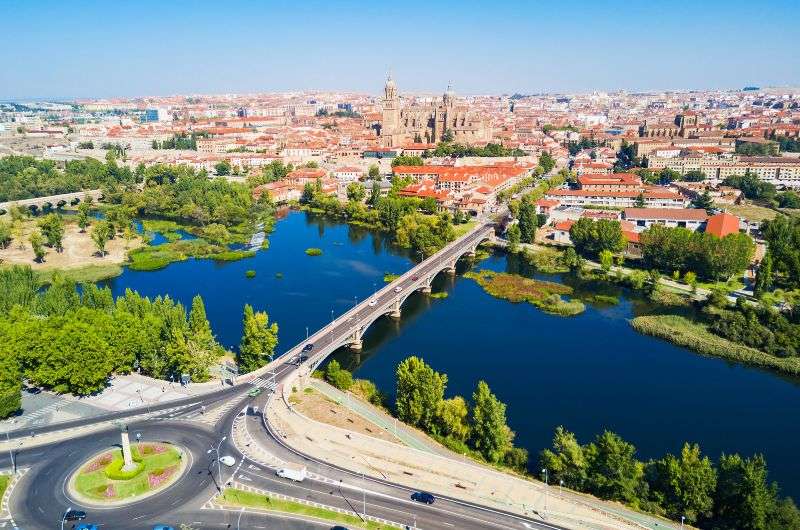
Cross this bridge and you're in Salamanca. Welcome!
Train station in Salamanca
Salamanca’s train station (Estación de Tren de Salamanca) is a walkable 1.5 km (0.9 mi) from the main square of the city, Plaza Mayor, or about 20 minutes for most folks.
Orientation
Salamanca is wonderfully walkable. All of the city’s major attractions are within its compact historic center. Easy peasy lemon squeazy.
Main attractions in Salamanca
- Plaza Mayor: Kick off your visit at this stunning Baroque square, often hailed as the most beautiful in Spain. Grab a coffee, sit back, and soak up the lively atmosphere. This comes with a warning: The coffee in Spain is tough, man. And by tough, I mean gross. Try Brooklyn & Co just off the main square for something that tastes better than dirty water.
- University of Salamanca: Founded in 1218, this venerable institution is one of the world’s oldest universities. Don’t miss the intricately carved facade of the university building—try spotting the hidden frog for good luck—and the library is pretty cool too.
- Salamanca Cathedral: This colossal complex includes both the Old Cathedral (Catedral Vieja) and the New Cathedral (Catedral Nueva). The artist that did the carvings out front was in a mood—make sure to look closely to find some of the whimsical creatures. Climb the tower for great views of the city.
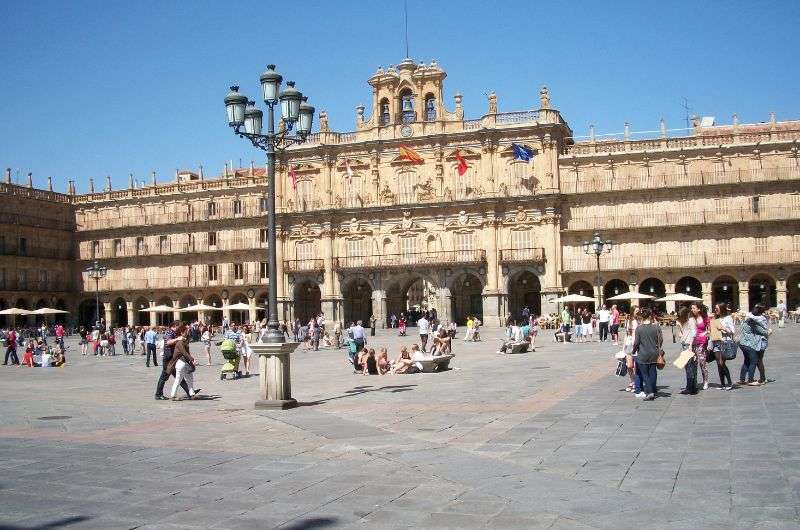
Plaza Mayor de Salamanca
- Casa de las Conchas: Famous for its facade adorned with over 300 scallop shells, this historic building now serves as a public library and exhibition space.
- Convento de San Esteban: A striking, pick-you-jaw-off-the-floor wow Dominican monastery with a richly decorated Plateresque facade and peaceful cloisters. I’m not religious, but I could see Jesus stopping by this place once in a while.
- Roman Bridge: This ancient bridge over the Tormes River offers picturesque views of the city and a glimpse into Salamanca’s Roman history.
- Museums: Don’t miss the Art Nouveau and Art Deco Museum housed in the Casa Lis, a stunning Modernist building. The Museo de Salamanca is also worth a visit for its eclectic collections.
And like I mentioned, you could, theoretically, stop by this next spot if you’re driving back to Madrid from Salamanca…
7. Day trip from Madrid to Chinchón
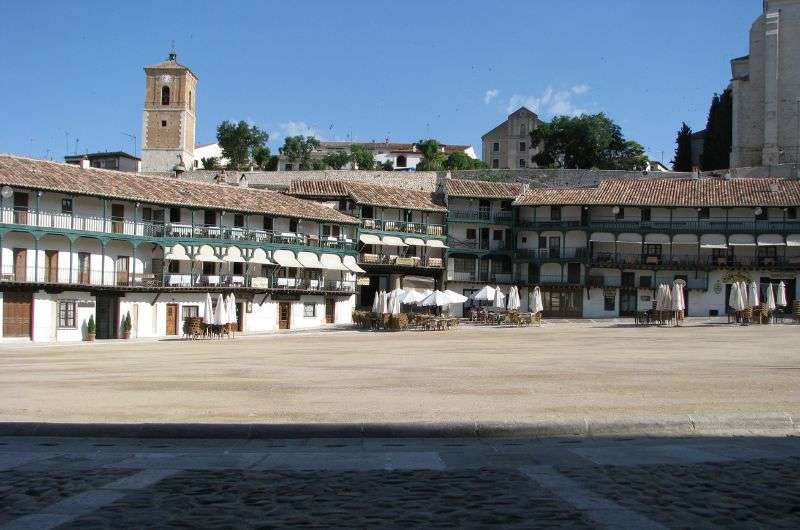
This is the main “square” in Chinchón that’s actually a circle, because it gets turned into a bullfighting ring
- Driving time: 45 minutes
- Train travel time: No direct train; best reached by car or bus
- Review: 5/10
- What it is: A village known for the main plaza that turns into a bullfighting ring and traditional Spanish ambiance
Chinchón, a cute village located just 45 minutes southeast of Madrid, is like stepping into a Spanish postcard. Famous for its unique Plaza Mayor that gets converted into a bullfighting ring several times a year, this village exudes old-world charm with its traditional architecture, winding streets, and lively atmosphere. To be honest, there’s not much else to see here, and I’m grasping at straws in the list of attractions below, so don’t get your hopes up too high.
This is a place for people that are into quaint villages with not much to do but soak in the atmosphere. Not really for me, but I thought I’d share anyway for those that like their day trips to be of the relaxed variant.
Getting there
Chinchón is best reached by car, taking about 45 minutes from Madrid. There are also buses from Madrid’s Conde de Casal station that will get you there in around an hour. Trains don’t comfortably go to Chincón.
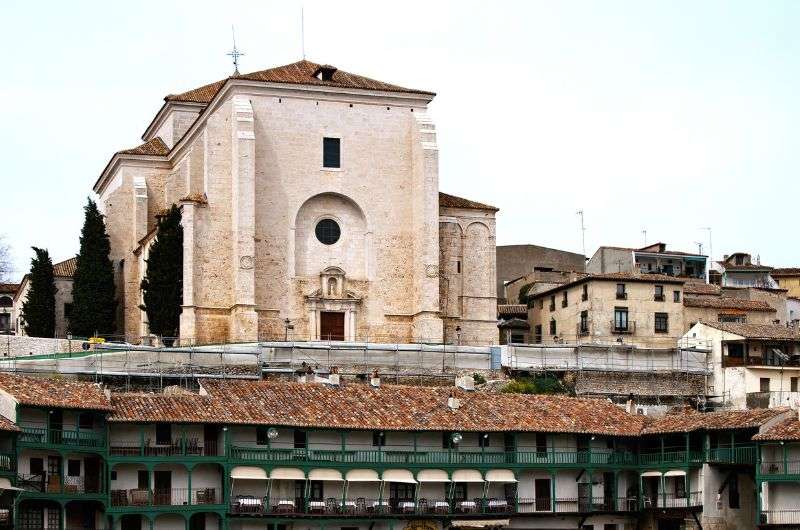
The green balconies are characteristic of Chinchón (bottom of photo), and the church has no tower!
If you’re continuing to (or coming from) Cuenca, that’ll take about 1 hour 20 minutes.
Orientation
Chinchón is small and easily walkable, with most attractions centered around the Plaza Mayor. Parking is available on the outskirts of the village, a short walk from the main square.
Main attractions in Chinchón
- Plaza Mayor: This historic square is the heart of Chinchón, surrounded by medieval buildings with wooden balconies. It’s often used for festivals, markets (every Saturday), and bullfights. Yes, the Plaza Mayor transforms into a bullfighting ring several times a year, especially during festivals like Easter and the Patron Saint Festivities in August. The atmosphere is electric, but if bullfighting isn't your thing, you can avoid these times and still enjoy the village’s charm.
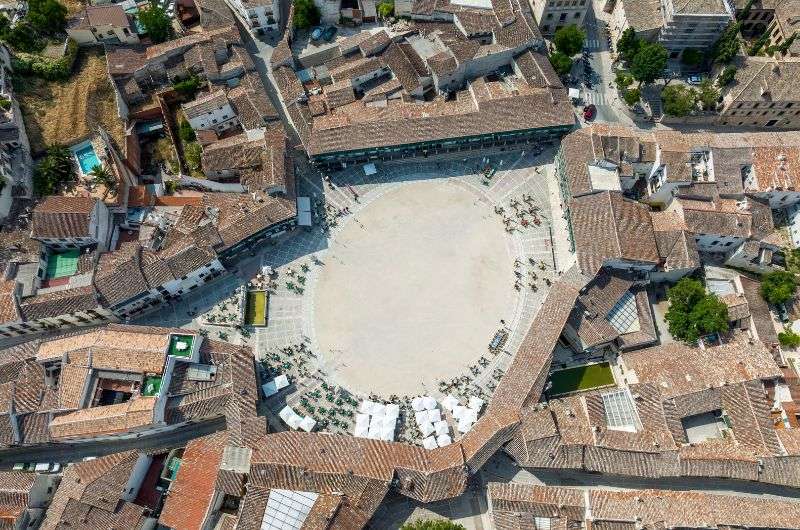
This is where the bullfighting happens. Wanna know my opinion of this tradition?
- Chinchón Castle (Castillo de los Condes): While not much more than ruins today, the castle offers views over the village and surrounding countryside. It’s a short walk uphill from the Plaza Mayor.
- Church of Our Lady of the Assumption (Iglesia de Nuestra Señora de la Asunción): This 16th-century towerless church houses a famous painting by Goya, who had family ties to the village.
- Clock Tower (Torre del Reloj): One of the few remaining parts of a church destroyed during the War of Spanish Succession. I guess it can be friends with the tower-less church on the main square.
- Wine and liqueur tastings: Chinchón is known for its anisette (anise-flavored liqueur). Visit one of the local bodegas to taste this and other regional wines. Not great if you’re on a day trip and driving though!
8. Hiking in Madrid: Sierra de Guadarrama

Check this and other beautiful photos on Alltrails.com
- Driving time: 1 hour
- Train travel time: About 1 hour from Madrid to Cercedilla
- Review: 8/10
- What it is: A stunning national park offering scenic hikes, fresh air, and a refreshing escape from the city
If you're craving nature and a break from Madrid’s urban hustle, Sierra de Guadarrama is your go-to day trip. This national park, located just an hour away from the city, offers a variety of hiking trails through pine forests, mountain peaks, and tranquil valleys. It’s the perfect place to stretch your legs, breathe in the crisp mountain air, and soak in some breathtaking views.
Getting there
Drive or take a train from Madrid to Cercedilla, which is a small town that serves as a gateway to Sierra de Guadarrama hiking. From there, trails like the Siete Picos or Camino Schmidt are easily accessible. The train ride is scenic and drops you right into the heart of the hiking area.
For those willing to go a bit further and have their own mode of transportation, several other trailheads are best reached by car, offering even more opportunities to explore the Sierra’s natural beauty.
Orientation
The park has well-marked trails for all levels, from leisurely walks to challenging climbs. Maps are available at the visitor centers, and trails are well-signposted.
Main Trails in Sierra de Guadarrama
- Camino Schmidt: A moderate trail winding through pine forests. It’s about 6 km (3.7 mi) long and perfect for a half-day hike. Accessible from Cercedilla.
- Siete Picos: For a more challenging hike, this trail covers the Seven Peaks, offering panoramic views of the park. It’s about 9 km (5.6 mi) and requires a solid level of fitness. Accessible from Cercedilla.
- La Pedriza: Known for its unique rock formations, this area offers a range of trails and is great for rock climbing enthusiasts. Accessible from Cercedilla.
- Laguna Grande de Peñalara: If you have access to a car, a drive to the Peñalara Massif is well worth it. The trail to Laguna Grande de Peñalara, the largest glacial lake in the area, is about 6 km (3.7 mi) round trip and offers stunning views of the surrounding peaks and valleys. It’s a relatively easy hike with a gradual ascent, making it perfect for families or those looking for a scenic but not overly strenuous adventure.

Check the Laguna Grande de Peñalara trail on Alltrails
- Puerto de Navacerrada: Another great spot accessible by car, Puerto de Navacerrada is a mountain pass that serves as a starting point for several trails, including the ascent to Bola del Mundo, one of the highest peaks in the region. The hike offers panoramic views and, on clear days, you can see all the way to Madrid!
- Cotos: The Cotos area offers access to several trails, including the popular route to the Peñalara summit, the highest peak in the Sierra de Guadarrama. The drive here is scenic, and once you arrive, you’ll find a variety of trails ranging from easy walks to more challenging climbs.
9. Beach day trips from Madrid: Valencia?
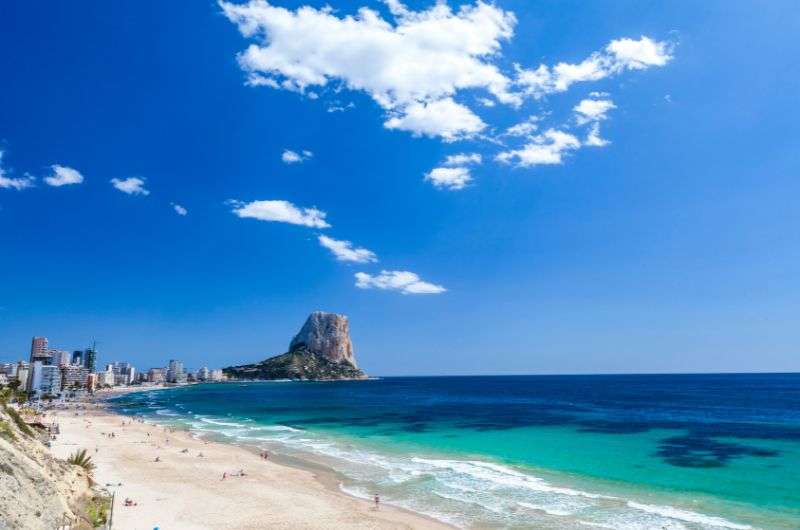
Is this what you’re hoping for on your beachy day trip from Madrid?
Alright, let's talk about beaches (you asked!). You’re in Madrid, a city smack dab in the middle of Spain. If you thought you were going to pack a beach towel and snorkel for a quick dip in the Mediterranean, think again. The closest stretch of sand you’ll find is Malvarrosa Beach in Valencia, but let me be clear: Madrid is about as beachy as Kansas.
Spoiler alert: I’m not in love with Valencia, but it does have its moments. The paella is worth trying and the beach is... well, it’s a beach.
- Driving time: 3.5-hour drive
- Train travel time: 2 hours on the high-speed train from Madrid Chamartín Station
- Review: 3/10
When you planned a trip to Madrid, were you really expecting a beach vacation? Madrid is a bustling metropolis, full of culture, history, tapas, and flamenco (here’s my Madrid guide)—not sandy toes and surfboards. I can't even imagine a beach on the Mediterranean that warrants 7 hours in a car in one day just to get there and back. If you're even thinking about this, let’s have a chat.
The (not so) closest beach to Madrid
- Malvarrosa Beach (Valencia): If you’re absolutely obsessed with the idea of a beach day, Valencia’s Malvarrosa Beach is technically the closest option. And by “close,” I mean a solid 2-hour journey one way on the fast train or 3.5 hours in the car. Are you relaxed yet? Sure, the train ride is scenic and Valencia’s got some charm (but not too much), but it's still a trek.
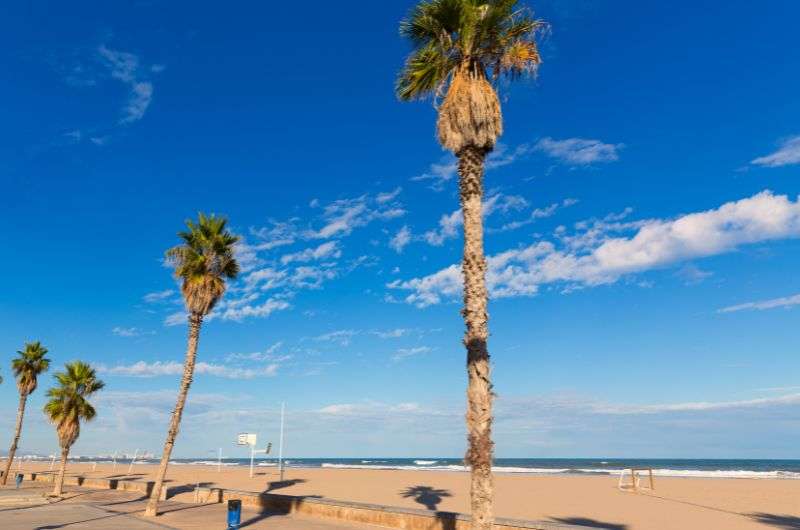
Malvarrosa beach in Valencia is the closest beach to Madrid
My take on this wild idea
If you’re desperate to get some sand between your toes, maybe, just maybe, consider making it an overnight trip. Spend the night in Valencia, check out the beach, and try the paella (because it’s Valencia, and it’s the law). But full disclosure: I’m not a huge fan of Valencia.
10. Day trip from Madrid to Andalusia? (Cordoba? Granada? Sevilla?)
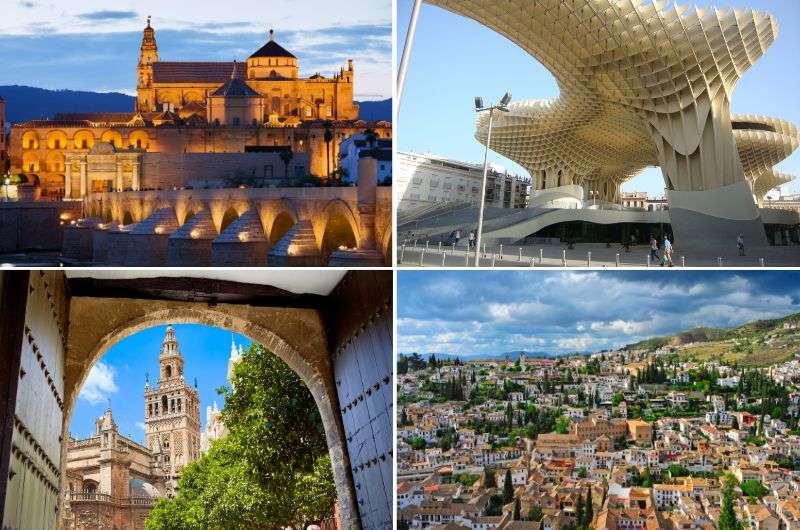
Are you hoping to visit one of these amazing places on your day trip from Madrid?
- Driving time: Too long to count
- Train travel time: 2-3.5 hours one way on the high-speed train from Madrid
- Review: 5/10 for a day trip, 10/10 for a proper visit
- What it is: A region rich in culture, history, tapas, and beauty, but way too far for a day trip from Madrid
Attempting to visit Andalusia as a day trip from Madrid is not just ambitious, it’s borderline masochistic. You’ll spend most of your day on the train or in the car and barely scratch the surface of what these incredible cities have to offer. Instead, save Andalusia for when you can truly immerse yourself in its beauty and history. That saying about having your cake and eating it too? Yeah, not today.
Andalusia, with its enchanting cities like Córdoba, Granada, and Sevilla, is an absolute gem in Spain. It's a region bursting with Moorish architecture, delicious (and sometimes free) tapas, flamenco rhythms, and a history that will blow your mind. I’m still trying to find mine all over the floor.

But here's the truth—Andalusia’s too far for a day trip from Madrid. Trust me, trying to cram any of the cities into a day trip is like trying to watch all the Lord of the Rings movies in one sitting—exhausting and a bad idea.
If you’re looking for a place to stay overnight (or 7), check out our guide to the best places in Andalusia for some great recommendations. The region warrants an entire vacation, not just a few days. My favorite city in Andalusia: Sevilla!
Tip: You only need 10 days to see the very best of Spain! That way you’ll cover Madrid and day trips from there, Barcelona, and yes, even Andalusia.
Day trip from Madrid to Córdoba
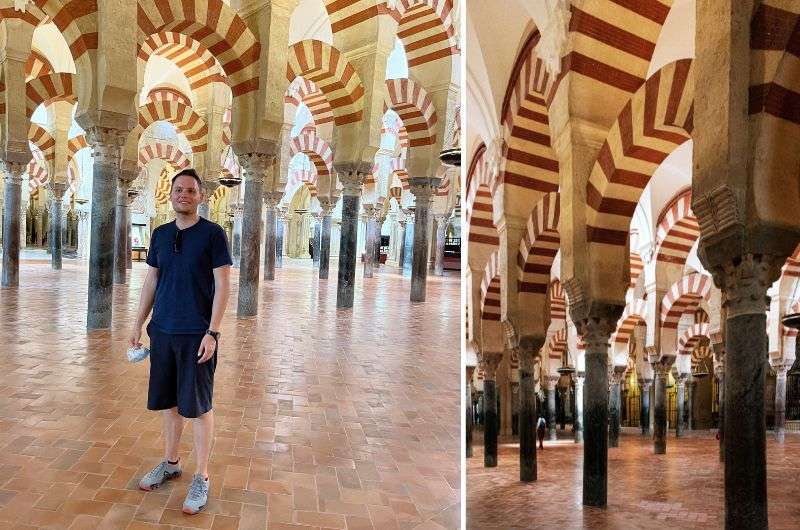
You have to see the Mezquita de Córdoba!
The high-speed train can get you from Madrid Atocha to Córdoba in about 2 hours, costing anywhere from EUR 16 to EUR 60.
Cordoba is home to the Mezquita, a mosque-cathedral that is one of the most impressive monuments in the world (or so they say). Córdoba also offers charming patios, Roman bridges, and a fascinating Jewish quarter.
Read my Cordoba guide for a full overview.
Day trip from Madrid to Granada
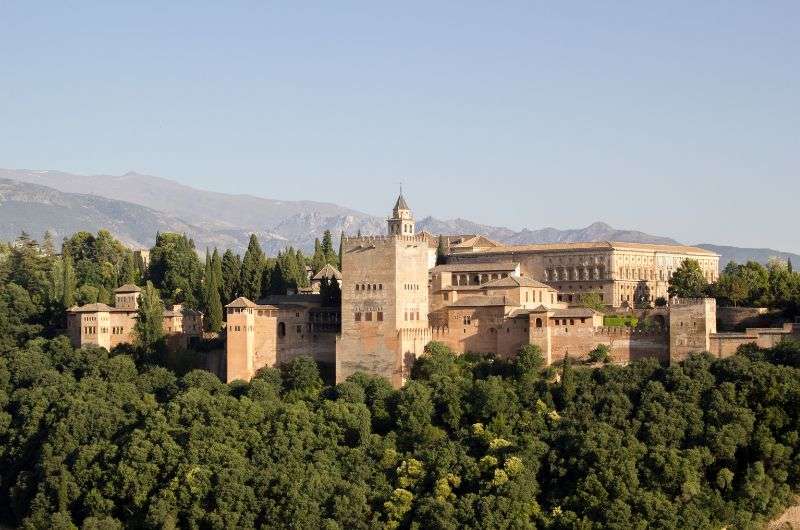
The Alhambra in Granada
The high-speed train can get you from Madrid Atocha to Granada in about 3.5 hours, costing around EUR 50.
The Alhambra alone warrants an overnight stay. This stunning palace and fortress complex is a marvel of Islamic architecture and history.
Read my Granada guide for a full overview. It is, on the other hand, a great day trip from Malaga.
Day trip from Madrid to Sevilla
The high-speed train can get you from Madrid Atocha to Sevilla in as little as 2.5 hours, costing around EUR 16 for the cheapest tickets! No wonder you’re considering a day trip from Madrid to Sevilla! But don’t do it. Leave Sevilla for another time when you can visit it properly unless you know this is the last time you’re visiting Spain in your life.
Highlights include the magnificent Seville Cathedral, the largest Gothic cathedral in the world. Inside, you’ll discover Christopher Columbus’s tomb, a breathtaking altarpiece, and the soaring Giralda tower, originally a minaret, offering panoramic views of the city. The sheer scale and artistry of this UNESCO World Heritage site will leave you in awe.
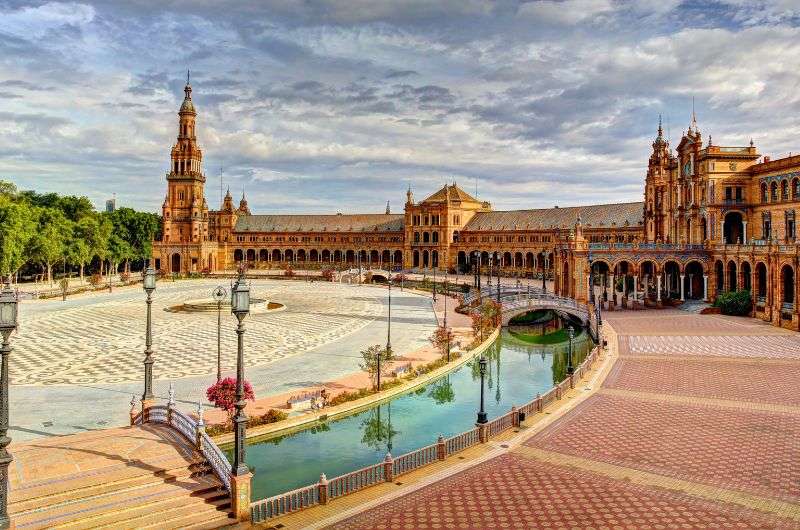
Sevilla has also a lot to offer!
Next, there’s the Real Alcázar, a royal palace that’s an extraordinary blend of Moorish, Gothic, Renaissance, and Baroque architecture. Its intricate tilework, lush gardens, and tranquil courtyards make it a true oasis in the heart of the city.
No visit to Sevilla is complete without a stop at Plaza de España. This vast, semi-circular plaza is a masterpiece of Spanish Renaissance Revival architecture, with a grand canal spanned by ornate bridges, intricate tilework, and a stunning central building. You can even paddle some little boats on the canal!
And those were just Sevilla’s basics. You can’t possibly do the city justice in a day. Read my Sevilla guide for a full overview.
11. Day trip from Madrid to Zaragoza? Maybe not
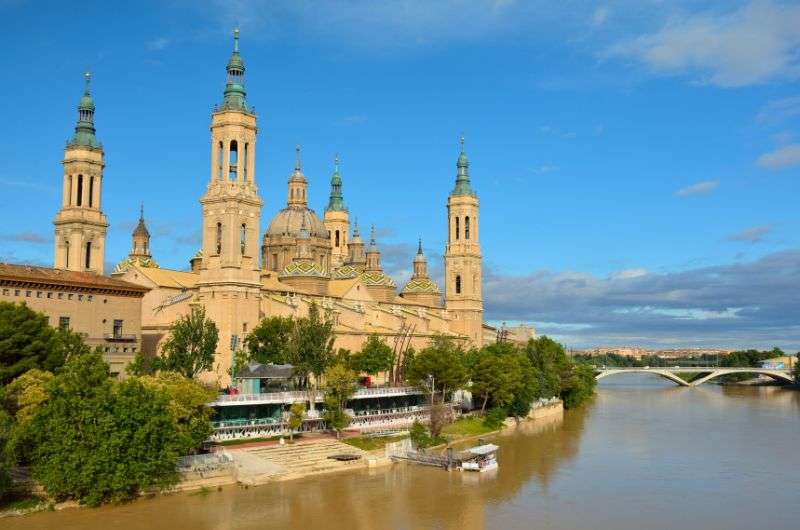
Zaragoza didn't win me over
- Driving Time: 3 hours
- Train Travel Time: 1 hour 15 minutes by high-speed train from Atocha Station
- Review: 5/10
- What it is: A city with a mix of historical and modern attractions, but lacking the excitement for a compelling day trip from Madrid
Zaragoza, Spain's fifth-largest city, is a place where I found myself asking, "Is this it?" Don't get me wrong, it has some highlights, but it’s not exactly bursting with excitement, and I was glad I was only stopping by on the drive from Barcelona to Bilbao.
With its historical landmarks, a few decent museums, and some impressive modern architecture, Zaragoza sounds promising on paper but falls flat in reality. If you're in Madrid and contemplating a day trip here, I’d advise you to think twice. That is, unless you’re traveling in October and can be there for the annual Fiestas de Pilar, the biggest festival in the city!
Maybe consider going if you really wanted to go to Andalusia but can’t. There’s some Moorish architecture in Zaragoza that could be like an appetizer before you get to go on a proper trip to Andalusia next time.
Getting there
The high-speed train from Madrid’s Atocha Station gets you to Zaragoza in 1 hour 15 minutes. Trains are frequent and reliable, and tickets start at EUR 25.
Driving takes about 3 hours, which can feel like an eternity for what Zaragoza has to offer.
Zaragoza Delicias train station
Zaragoza’s train station is called ‘Delicias’ and is located 3 km (1.8 mi) to the west of the city center. You’ll want to take a taxi from there to the main sights. Or, first stop by the Aljafería Palace, which is about halfway between the two.
Orientation
Zaragoza is fairly easy to navigate on foot. The main attractions are all clustered around the city center; the Aljafería Palace is the only highlight in Zaragoza that’ll require some transportation (or 30 minutes of walking through the boring parts of town).
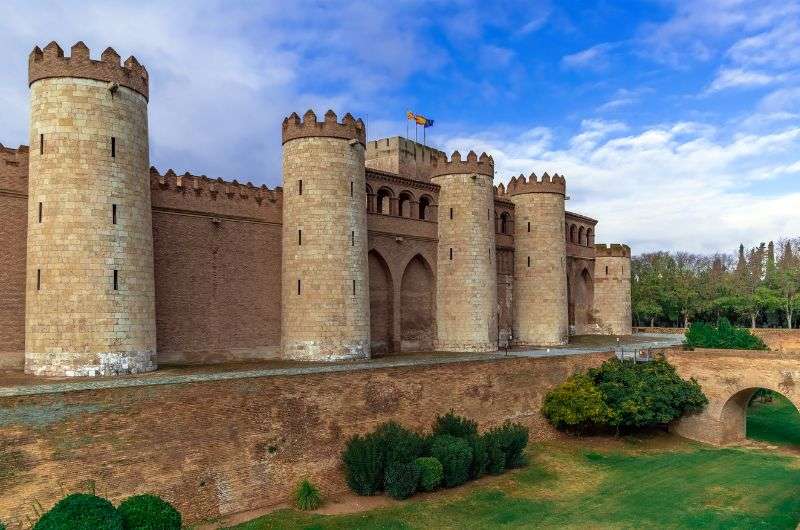
Aljafería Palace
Main attractions in Zaragoza
- Basilica of Our Lady of the Pillar: Reportedly the first church dedicated to Virgin Mary. This iconic cathedral is Zaragoza’s crown jewel and a significant pilgrimage site. It's stunning, but once you've seen it, you've seen the best the city has to offer.
- Aljafería Palace: It is considered one of the most important Islamic monuments in Spain. It's a fortified medieval Islamic palace that now houses the Aragonese Parliament, which makes visiting a little tricky. Book online in advance and be shuffled around in a group of other tourists as to not disturb daily business.
- La Seo Cathedral: Another cathedral—yes, it's beautiful, but how many cathedrals can you see before they all start to blend together? This one is a tad different, because it used to be a mosque. Inside, you will also find a museum with a tapestry collection. It’s supposed to be a world-class collection. I mean they’re wall rugs. Take it or leave it.
- Puente de Piedra: An ancient stone bridge with decent views of the Basilica and the Ebro River. It's picturesque but not exactly thrilling.
- Goya Museum: If you’re a hardcore Goya fan, this might pique your interest. For the rest of us, it’s a “meh.”
- Origami Museum: Truthfully, this place was awesome! Forget Goya Museum and come here instead. These aren’t just cooler versions of swans and boats, these are masterpieces. It’s the first museum of its kind in Europe and shows original models of the most important folders in the world. Who knew there even was such a thing.
Unless you have a particular reason to visit Zaragoza—like a burning desire to see the Basilica of Our Lady of the Pillar or a deep interest in Goya—it might not be the best use of your precious day trip from Madrid.
Sometimes, all you need to do is take the first step... find your dream hotel in Madrid now
Save it for yourself to come back to later, or share with your friends on social media!
I've already planned your ititnerary for the trip, complete with my travel tips.
You might also be interested in reading:
- Andalusia Itinerary: Southern Spain in 10 Days
- Barcelona Itinerary: 5 days in Gaudí’s Metropole (with day trips)
- All You Need to Know about Spanish Tapas (+Restaurant Tips)
- The 10 Best Museums in Spain’s Top Cities
- The 16 Most Beautiful Beaches in Spain
This post contains affiliate links. I earn a small commission if you make bookings through my links, at no additional cost to you. Thank you for your support!


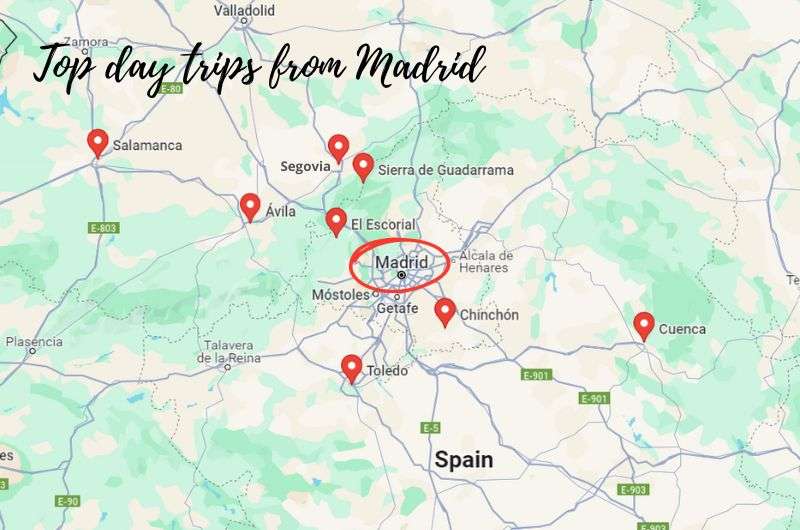








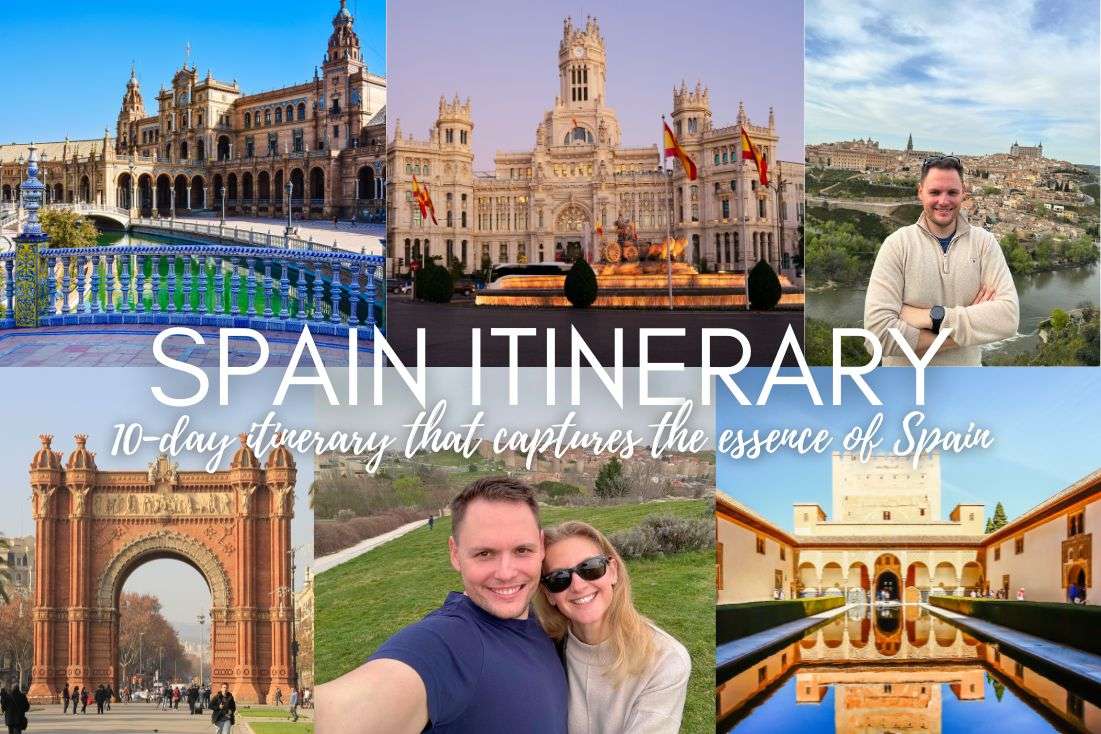

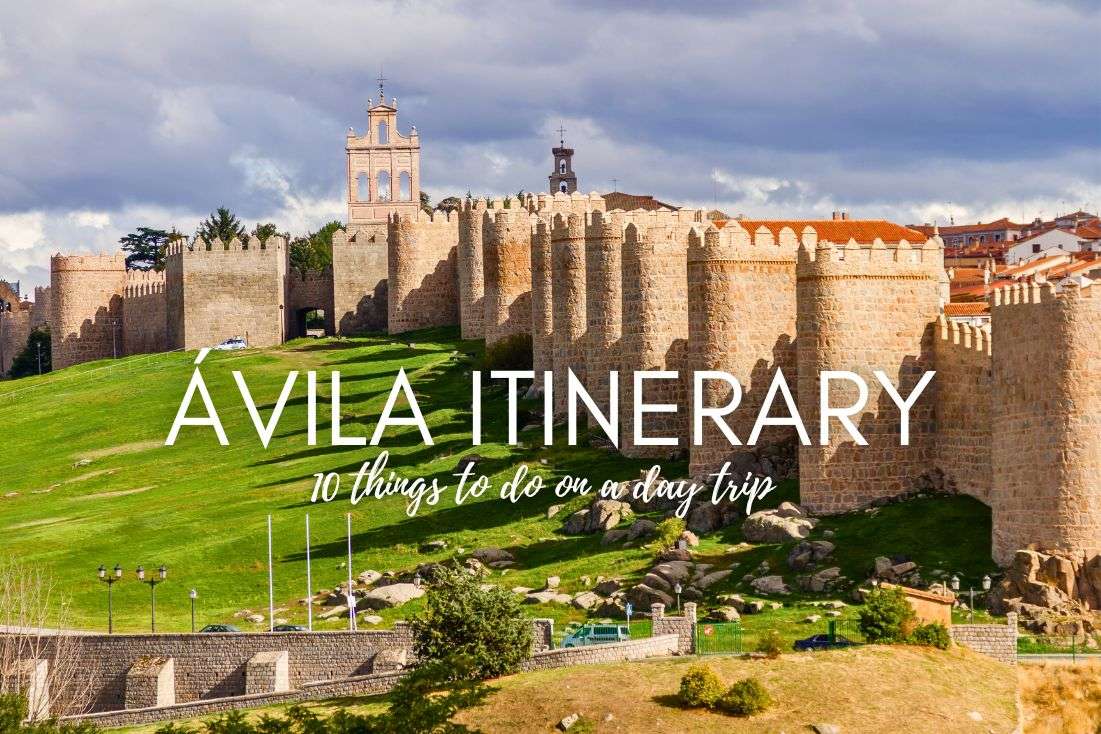



Comments | Thoughts? Give us a shout!